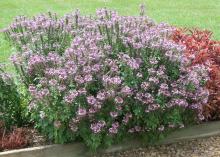Information Possibly Outdated
The information presented on this page was originally released on April 8, 2013. It may not be outdated, but please search our site for more current information. If you plan to quote or reference this information in a publication, please check with the Extension specialist or author before proceeding.
Senorita Rosalita, Sparkler cleomes are good in gardens
One of the flowering plants I remember from my youth is the cleome. I loved these tall plants with flowers I thought looked a little spidery.
Many years later, when I rediscovered cleome growing in my neighbor’s yard, I reached out for a closer look at the flowers and was suddenly reminded of the one aspect I did not like about these plants. I had forgotten about the thorns and had impaled my thumb.
Senorita Rosalita cleome is an exciting thornless cleome that was introduced several years ago for the garden and landscape. It is a strong summer performer across the Southeast, blooming freely all summer long. In 2009, Senorita Rosalita was selected as a Mississippi Medallion winner. In 2012 Louisiana Super Plant status was conferred on this plant.
Did I mention that the plant does not have thorns?
Older cleome varieties, while being flowering annuals, easily attained perennial status because they had prolific seed production. This could become a problem for home gardeners who like to change things up in the garden each year. If you are this kind of gardener, Senorita Rosalita is ideal for you because it does not produce viable seeds, so reseeding is not a problem.
Senorita Rosalita’s growth habit is compact, typically growing 24 inches tall and 20 inches wide. The plants may get a little larger in some locations. Senorita Rosalita also has dense growth, preventing the “bare knees” that some of the older varieties develop.
Other cleome varieties that are garden-worthy are the Sparklers, available in white, pink and lavender. Sparkler Blush cleome was named an All-America Selections in 2002. These plants have a bushy growth habit and reach about 36 inches tall. Sparkler has the potential to reseed, but subsequent generations will likely resemble one of the breeding parents.
Cleomes are strictly warm-weather flowering perennials and need to be planted once soil temperatures have warmed. It’s much easier to use transplants that are ready to start flowering. Select a planting site that has full sun at least part of the day. Well-amended landscape soil that has good drainage is ideal, and don’t forget to mulch after transplanting.
Cleomes are tolerant of drought conditions once the root system gets established, but they need supplemental watering during extended dry periods. Fertilize at planting and again about midsummer using a slow-release fertilizer.
Cleomes make great combination partners in the sunny mixed landscape. Plant towards the back and don’t crowd the plants together. Once the cleomes start to grow out, the flower heads can cause the branches to arch. Resist the urge to stake the taller varieties. The gentlest breeze can sway the arching branches, adding movement to landscape.
Combine with carpets of flowering vinca or supertunia. Larger garden partners include salvia and Amazon dianthus.
Senorita Rosalita and Sparkler cleome offer interesting textures to the garden for you and your neighbors to enjoy.









